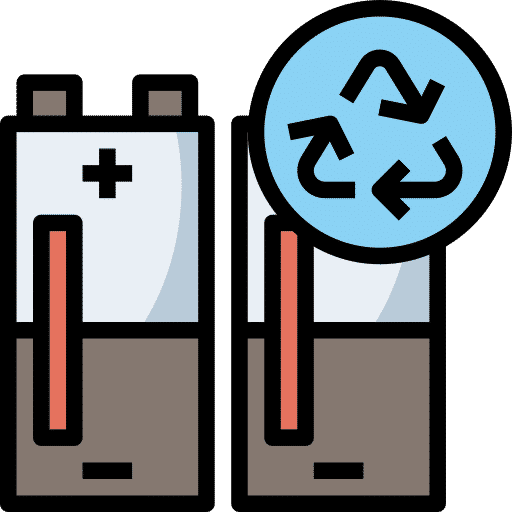Lead-acid: an outdated technology ☠️
Lead Acid Batteries
Olenergies Batteries
Only 30 to 50% of the energy used is available !
A lead-acid battery discharges at only 30-50% of its overall capacity. Beyond that, there is a sulphation phenomenon
Replaces 2 lead acid batteries advantageously
Our batteries can be discharged almost completely without degrading; 100% useful capacity !
Very short service life: 300-500 cycles
On average, a lead acid battery is replaced every 2 years
Very long service life: 3000-5000 cycles
Our systems are designed for a minimum of 3,000 cycles or many years of use !
Unsecured
Multiple hazards such as potentially explosive gases and corrosive sulphuric acid
100% secured
The cell is intrinsically safe; no risk of fire or explosion
Lead is very heavy
The mass energy density of lead is the lowest of all existing battery technologies
Very light batteries
An Olenergies battery is about 60% lighter than a lead-acid battery for the same capacity !
Mandatory slow charging
Charging must be done slowly to avoid heating the internal chemical elements
Fast charging
It is not necessary to follow a load curve and the chemical elements do not heat up.
No partial load
Lead acid battery must be charged regularly at 100% to avoid shortening its life due to sulphation
Partial charging and discharging; no problem
The service life improves even slightly with partial charging instead of full charging.
High losses if the discharge is fast
Peukert’s Law: the more the lead battery is used, the less energy it will provide
No discharge losses
One of the great advantages of Olenergies batteries is that Peukert’s losses are almost non-existent.
No energy management
Lead batteries work without electronic boards
On-board intelligence
Right to error: our BMS is a “safeguard” that will intervene in the event of an anomaly
High losses during charging
Between 15 and 20% of the charging energy is lost during the charging process
Efficiency close to 100%
All the energy that charges our batteries is stored and not lost
Voltage drop with discharge
The voltage (V) of a lead acid battery decreases with discharge
Equal voltage throughout the discharge
Olenergies batteries provide the same voltage levels throughout the discharge
environment-unfriendly
Lead and acid are dangerous and toxic elements, including during recycling
Eco Friendly
No toxic or dangerous elements, for man or the planet. so no cobalt and never lead-acid
Lead Acid Batteries
Only 30 to 50% of the energy used is available!
A lead-acid battery discharges at only 30-50% of its overall capacity. Beyond that, there is a sulphation phenomenon
Very short service life: 300-500 cycles
On average, a lead acid battery is replaced every 2 years
Unsecured
Multiple hazards such as potentially explosive gases and corrosive sulphuric acid
Lead is very heavy
The mass energy density of lead is the lowest of all existing battery technologies
Mandatory slow charging
Charging must be done slowly to avoid heating the internal chemical elements
No partial load
Lead acid battery must be charged regularly at 100% to avoid shortening its life due to sulphation
High losses if the discharge is fast
Peukert’s Law: the more the lead battery is used, the less energy it will provide
No energy management
Lead batteries work without electronic boards
High losses during charging
Between 15 and 20% of the charging energy is lost during the charging process
Voltage drop with discharge
The voltage (V) of a lead acid battery decreases with discharge
Eco-Destructive
Lead and acid are dangerous and toxic elements, including during recycling
Olenergies Batteries
Replaces 2 lead acid batteries advantageously
Our batteries can be discharged almost completely without degrading; 100% useful capacity!
Very long service life: 3000-5000 cycles
Our systems are designed for a minimum of 3,000 cycles or many years of use !
100% secured
The cell is intrinsically safe; no risk of fire or explosion
Very light batteries
An Olenergies battery is about 60% lighter than a lead-acid battery for the same capacity !
Fast charging
It is not necessary to follow a load curve and the chemical elements do not heat up.
Partial charging and discharging; no problem
The service life improves even slightly with partial charging instead of full charging.
No discharge losses
One of the great advantages of Olenergies batteries is that Peukert’s losses are almost non-existent.
On-board intelligence
Right to error: our BMS is a “safeguard” that will intervene in the event of an anomaly
Efficiency close to 100%
All the energy that charges our batteries is stored and not lost
Equal voltage throughout the discharge
Olenergies batteries provide the same voltage levels throughout the discharge
Eco Friendly
No toxic or dangerous elements, for man or the planet. so no cobalt and never lead-acid

The best money value on the market
All the advantages provided by Olenergies batteries immediately make the initial cost profitable, which is more than offset by a fourfold longer service life, superior reliability, excellent efficiency and a minimum weight and volume reduced by half !
CASE STUDY

At the end of the number of cycles performed, Olenergies batteries still have a nominal capacity greater than 80% of the original capacity; they will continue to operate for a long time !
Ship us your used lead acid batteries !
We will give you a credit note on your next purchase of new lithium batteries. Save time, we’ll manage recycling process for you !


Ship us your used lead acid batteries !
We will give you a credit note on your next purchase of new lithium batteries. Save time, we’ll manage recycling process for you !

















































